Key Concepts
A region in which a portion of a tectonic plate sinks beneath another plate into the Earth's interior. Subduction zones are defined by deep oceanic trenches (Fig. 1), lines of volcanoes parallel to the trenches, and zones of large earthquakes that extend from the trenches landward.
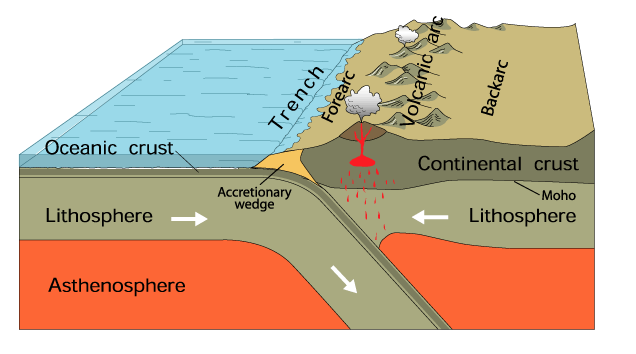
Plate tectonic theory recognizes that the Earth's solid surface is composed of a mosaic of interacting lithospheric plates, with the lithosphere consisting of the crust (continental or oceanic) and associated underlying mantle, for a total thickness that varies with age but that is typically about 100 km (60 mi). Oceanic lithosphere is created by seafloor spreading at mid-ocean ridges (divergent, or accretionary, plate boundaries) and destroyed at subduction zones (at convergent, or destructive, plate boundaries). At subduction zones, the oceanic lithosphere dives beneath another plate, which may be either oceanic or continental. Part of the material on the subducted plate is recycled back to the surface (by being scraped off the subducting plate and accreted to the overriding plate, or by melting and rising as magma) and the remainder is mixed back into the Earth's deeper mantle. This process balances the creation of lithosphere that occurs at the mid-ocean ridge system. The convergence of two plates occurs at rates of 1–10 cm/yr (0.4–4 in./yr) or 10–100 km (6–60 mi) per million years (Fig. 2).
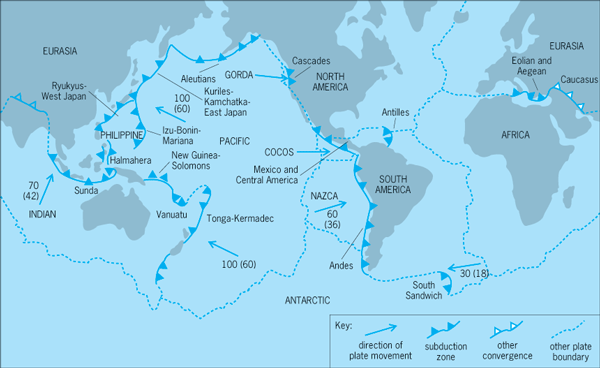
During subduction, stress and phase changes in the upper part of the cold descending plate produce earthquakes in the upper portion of the plate, in a narrow band called the Wadati-Benioff zone (named after the Japanese and U.S. seismologists who first recognized this feature) that can extend as deep as 700 km (420 mi). The plate is heated as it descends, releasing water and melts of subducted materials upward into the overlying mantle. This material lowers the melting temperature of the overlying mantle, causing it to melt. Mantle melts rise to produce the volcanic chains that are one of the most striking features of subduction zones. Because convergent margins sometimes comprise parallel trenches and volcanic chains that outline sectors of circles on maps (for example, Aleutians, Marianas, and Lesser Antilles), they are sometimes called arcs. See also: Lithosphere
The surface expressions of each subduction system can be divided into a forearc region, between the trench and the volcanic chain; a volcanic arc, the chain of active volcanoes running parallel to the trench; and a back-arc region, farthest removed from the trench (Fig. 3). Subduction zones can be divided in two ways, based either on the nature of the crust in the overriding plate or on the age of the subducting plate. The first classification yields two broad categories: those beneath an oceanic plate, as for the Mariana or Tonga subduction zones and those beneath a continental plate, as along the west coast of South America (Fig. 2). The first type is known as an intraoceanic convergent margin and the second is known as an Andean-type convergent margin. The second classification yields two end-member types (between which there is a continuum of intermediate types): Chilean and Mariana (Fig. 4). Chilean-type subduction zones consume young (<50 million years old) lithosphere which is hot and thin and therefore relatively buoyant. This lithosphere resists reinjection into the higher-density mantle and is associated with Wadati-Benioff zones that dip gently, have a lot of seismic activity, and are associated with back-arc compression. In some cases, the hot subducted slab may melt. Mariana-type subduction zones consume old lithosphere (>100 million years old), which is cold and thick and therefore of greater density than the underlying mantle. This lithosphere sinks readily into the mantle and is associated with Wadati-Benioff zones that dip steeply, have little seismic activity, and are associated with back-arc extension. Because the seafloor of the western Pacific is much older than that in the eastern Pacific, most Mariana-type subduction zones are in the western Pacific and most Chilean-type margins lie along the margins of the eastern Pacific. See also: Mid-Oceanic Ridge; Plate tectonics
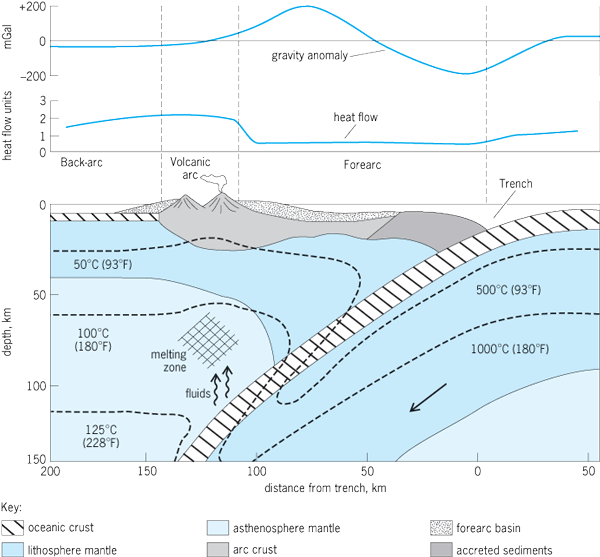
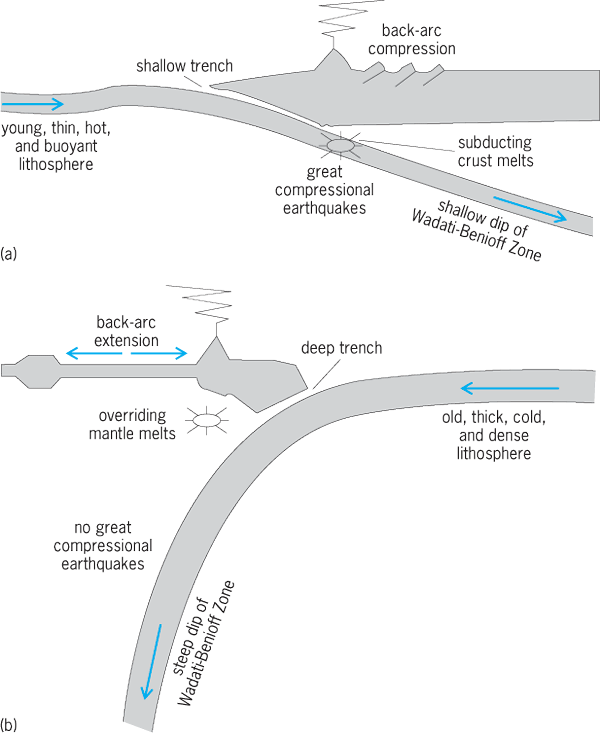
Geometry and geophysics
The subducting plate bends and begins its descent into the mantle at the oceanic trench. The bend of the plate increases until the slab dips into the mantle at angles of 10–70° beneath the volcanic arc; however, in some cases, as in the Marianas, the slab descends nearly vertically beneath the active arc. The cold oceanic plate cools the surrounding mantle and produces unusually low temperatures at great depths (Fig. 3). The presence of this cold, dense slab results in very low heat flow values beneath the forearc and a positive gravity anomaly in the middle of the forearc (Fig. 3). The characteristic low gravity in the outer (toward the trench) part of the forearc results from the accumulation of lower-density sediment and fractured rock at the interface of the two plates. See also: Earth's gravity field; Earth's heat flow
Earthquakes are limited to the uppermost 50 km (30 mi) of the Earth everywhere but in subduction zones, where they may occur at up to 14 times greater depths. This reflects the unusually cold nature of the Earth in subduction zones. On a subducting plate, the first seismic region occurs on the ocean side of the trench, where the massive plate is first bent downward. As the plate first passes beneath the overriding plate, shallower earthquakes result from release of stress between the two moving plates. Earthquakes along the plate interface at depths of 20–50 km (12–30 mi) can be especially destructive and cause tsunamis, such as those that devastated Sumatra in 2004 and northeast Japan in 2011. At greater depth, the array of earthquakes defines a dipping zone of seismicity called the Wadati-Benioff zone (Fig. 5). Quakes deeper than 300 km (180 mi) may be caused by phase changes in minerals within the plate as it moves to higher pressures, the most important of which is the conversion of olivine (Mg2SiO4) to a denser structure. A double zone of seismicity is often seen at these depths: one near the plate interface and the other 50 km (30 mi) or so deeper within the subducted mantle lithosphere. Descending slabs no longer produce earthquakes at depths >660 km (400 mi). However, studies of the deeper mantle using seismic waves (seismic tomography) have found evidence that the subducting lithosphere can remain intact and can be identified on a basis of variations in seismic velocities down to the base of the mantle (Fig. 6). Similar studies also identify subducted lithospheric slabs that have not been able to penetrate the boundary found at 660-km depth in the mantle (Fig. 6). This is accomplished by identifying regions where seismic velocities are fast relative to the surrounding mantle, which corresponds to cold, subducted material (color areas in Fig. 5 and Fig. 6). See also: Computerized tomography; Earth interior; Earthquake; Seismology
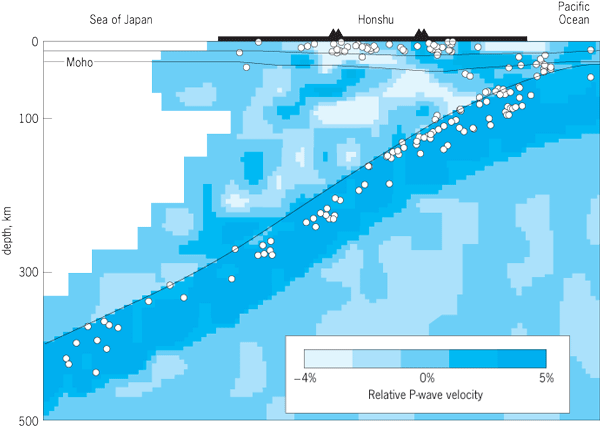
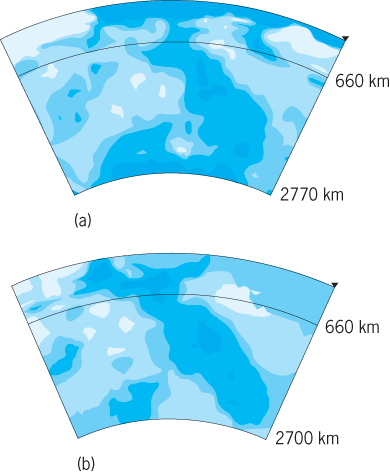
Magmatic processes
Active volcanoes are highly visible features caused by subduction zone processes. The volcanoes that have developed above subduction zones in East Asia, Australasia, and the western Americas surround the Pacific Ocean in a so-called Ring of Fire. At intraoceanic convergent margins, volcanoes may be the only component above sea level, leading to the name: island arc. The more general term, volcanic arc, refers to volcanoes built on either oceanic or continental crust. The term magmatic arc includes all of the igneous rocks (volcanic and plutonic) above a subduction zone. Arc volcanoes occur 100–200 km (60–120 mi) above the Wadati-Benioff zone. This means that the distance of the volcanic front (the main line of active volcanoes) from the trench varies with the dip of the downgoing plate. In the Peru-Chile subduction zone, for example, the slab dips at an angle of 35° and the volcanoes are 250–500 km (150–300 mi) behind the trench, while in the Kermedec subduction zone, north of New Zealand, the slab dips at 65° and the volcanic front lies only 170 km (100 mi) behind the trench.
Arc volcanoes erupt a variety of lavas, including basalt [rocks with less than 53% silicon dioxide (SiO2)], andesite (53–63% SiO2), and dacite (greater than 63% SiO2). Basalt and andesite are the dominant volcanic products, though their relative proportions vary: arcs like those in the Oregon Cascades and the Marianas are dominated by basalt, while arcs in Japan and the Washington Cascades are more than half andesite. The eruptions at subduction-zone volcanoes are commonly explosive because the magmas have both high amounts of silica (yielding very viscous magmas) and high contents of gases such as water vapor. The eruptions produce both lavas and fragmental, or pyroclastic, material; the alternating layers of flows and ashes or breccias build steep-sided edifices known as composite volcanoes. Some magmas cool at depth to become plutonic rocks and these may be exposed by erosion. The great masses of granitic rocks found today in the Sierra Nevadas of California formed this way about 100 million years ago at the site of an ancient Andean-type convergent plate boundary. See also: Andesite; Basalt; Breccia; Dacite; Magma; Pyroclastic rocks
Most subduction zone melts are generated in the mantle “wedge” overlying the subducting plate. Pressure and heating releases water and other volatile fluids from the cold, wet subducting plate as it passes below 100 km (60 mi). Subducted sediments may also melt. These fluids and melts carry many of the more mobile elements with them (especially alkali metals and alkaline earths) and leave less mobile elements (zirconium, titanium, niobium, and so on) as residues. As these fluids and sediment melts percolate upward, they lower the melting temperature of the overlying mantle by about 200°C (360°F), causing that mantle to melt. This effect is much the same as the freezing-point depression produced by adding antifreeze to water. The melts produced from the mantle are largely basalts, but with distinctive chemical compositions imparted to them by the water and mobile elements carried by fluids and sediment melts from the subducting plate. As these basaltic melts rise to the surface, they fractionate (cool and lose some solid crystals), and react chemically with the oceanic or continental crust through which they must pass on the way to the surface. These reactions modify the composition of the original melt to yield a variety of different lava types at the surface. There are a very few volcanic arcs that erupt lavas whose chemistry indicates that they melted from the subducting slab itself; this happens when very young, hot oceanic crust is subducted. The rocks formed from these lavas are called adakites, after Adak Island in the Aleutians, where they were first described. See also: Lava; Volcano
Most of the continental crust is formed above subduction zones. Continental crust is distinct from oceanic crust in being thicker, older, and of more fractionated composition. When an intraoceanic convergent plate boundary forms, the crust of the overriding plate is about 6 km (3.6 mi) thick. Magmatic thickening of the crust quickly yields a crust that is about 20 km (12 mi) thick (Fig. 7). This is about halfway to the about 40-km (25-mi) thickness of continental crust, which is obtained by collision between multiple sets of thickened intraoceanic convergent margins taking place over many millions of years. This process can be seen today in Indonesia. The formation and accretion of intraoceanic arc systems, operating over 4.5 billion years of Earth history, is thought to have produced all of the continents. Continental crust is also destroyed by subduction, as is happening today in northern India and Arabia, some of which are being subducted beneath southern Asia. At present, there seems to be an approximate balance between the volumes of continental crust created and destroyed by subduction.
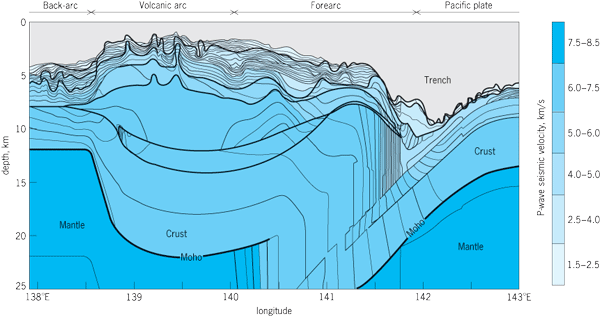
Forearc processes
The forearcs of subduction zones, between the trench and the volcanic arc, are where much of the mechanical interaction between the overriding and subducting plates occurs. Forearcs are classified as accretionary or nonaccretionary. Accretionary forearcs are those in which layers of sediment carried into the trench are scraped off the subducting plate and added to the upper plate as deformed, fault-bounded slices (Fig. 8). The addition of successive slices of sediment causes the overriding plate to build outward and the older accreted material to be uplifted and rotated landward (Fig. 8) to form accretionary prisms. The off-scraped material is commonly sand or silt deposited by density flows known as turbidity currents; these are high-velocity, water-supported flows which carry terrigenous sediment off the adjacent continent or volcanic arc into the trench (turbidites). The turbidites are deposited on top of older fine-grained pelagic (deep-ocean) sediments carried into the trench on the subducting oceanic crust. As the plate moves downward beyond the trench, most of the turbidites and some of the pelagic sediments are deformed and accreted to the upper plate, while the remaining sediment is subducted with the lower plate. The deformation and compaction of the accreted sediments release a large amount of water, which moves through the forearc, either diffusely or following faults. These fluids play an important role in transporting soluble chemicals in the shallow subduction zone. Submarine vents associated with this fluid flow have been found in the forearcs of the Cascadia Trench and the Mariana Trench. See also: Hydrothermal vent; Marine sediments; Turbidite; Turbidity current
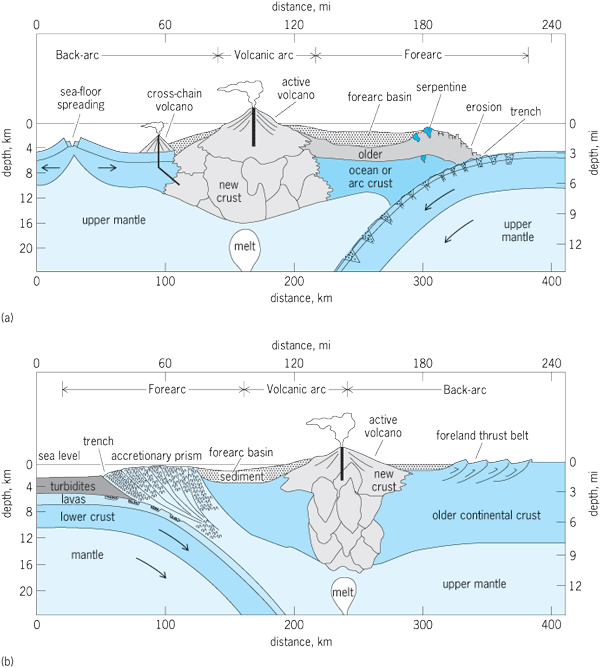
Trenches that lack a thick sequence of turbidite sands usually have nonaccretionary forearcs (Fig. 8). The sediments that reach these trenches are entirely subducted, to be either underplated (added to the base of the crust) to the upper plate at deeper levels or carried down and mixed back into the mantle. Such forearcs are actually abraded by the downgoing plate. Grabens (fault-bounded basins) develop in the lower plate as it bends into the trench; as the graben passes beneath the forearc, pieces of the forearc collapse into the graben and are carried down into the mantle. With time, the for-arc is eroded back toward the volcanic arc. This process, subduction erosion, typically removes 1–2 km (0.6–1.2 mi) of forearc per million years. Subduction erosion is accelerated when there are large seamounts or plateaus on the subducting plate; these features pass beneath the forearc, fracturing and weakening it and accelerating landsliding that removes forearc crust and delivers it to the trench. Fluids are released in nonaccretionary forearcs, too, by the dehydration of the thin sedimentary sequence and the heating of altered volcanic rocks in the lower plate. In some forearcs, these fluids move into the overlying shallow mantle and convert the water-free olivine (Mg2SiO4) in the mantle to less dense serpentine [Mg3Si2O5(OH)4]. This serpentine, because of its low density, rises into the for-arc crust to form diapirs and seamounts (Fig. 4). See also: Diapir; Graben; Seamount and guyot
The middle portion of the forearc is floored by igneous or metamorphic rocks that may be older continental crust, ocean crust trapped when the subduction zone began, or crust produced by older arc volcanoes. This crust is covered by sediments including those derived from the adjacent arc volcanoes, forming a forearc basin. These sediments are transported into the forearc basin either by wind or by turbidity currents. Forearcs near continents may be thickly covered in sediments and have broad accretionary prisms, but not intraoceanic forearcs. See also: Metamorphic rocks
Back-arc processes
Depending on the age of the seafloor being subducted, the regions behind the volcanic front may exhibit either extensional or compressional tectonics. Chilean-type subduction zones are characterized by strong coupling between the two plates (Fig. 4 and Fig. 8). These subduction zones typically have shallow dips and high earthquake activity; their back-arc regions develop foreland fold-and-thrust belts in which seaward-dipping faults stack up slices of crustal material (Fig. 8). Mariana-type subduction zones show a very different type of interaction between the upper and lower plates. These typically have steeply dipping slabs; these steep dips result from the vertical sinking of the slabs. A consequence of this motion is that the slab rolls back; that is, the hinge at which it bends moves away from the volcanic arc. This change requires that the trench move as well and that the upper plate is stretched or extended. This extension is usually accommodated by the development of a small mid-ocean ridge spreading center just behind, or within, the volcanic arc. These small ocean basins are known as back-arc basins and their development is episodic. They begin by splitting apart the weakest part of the arc system, the active volcanic chain. Seafloor spreading in the basin moves one part of the arc away from the trench, where it eventually becomes extinct and forms a remnant arc. The other part of the volcanic chain remains active and moves with the forearc and the trench. The successive waxing and waning of back-arc seafloor spreading has left a chain of extinct volcanoes and small oceanic basins behind some subduction zones, particularly in the western and southwestern Pacific.
Orogeny
An eventual consequence of subduction is orogeny, or mountain building. Subduction zones are constantly building new crust by the production of volcanic material or the accretion of oceanic sediments. However, the development of the greatest mountain ranges—the Alps or the Himalayas—occurs not during “normal” subduction but during the death of a subduction zone, when it becomes clogged with a large continent or volcanic arc. Because of the subduction of oceanic lithosphere, ocean basins eventually narrow and close. This closure results in large blocks of relatively buoyant continental crust being carried closer and closer together. The eventual collision of such large blocks produces the folding and faulting that raises the great mountain ranges. The closure of an ancient ocean basin along a north-dipping subduction zone carried India into Asia about 50 million years ago, producing the orogeny that is still raising the Himalayas. A similar process is happening on the north side of Arabia, which is colliding with Turkey and Iran. An ongoing collision, still in the early stages, is carrying the edge of the Australian continent downward below the island of Timor along another north-dipping subduction zone. Collisions destroy subduction zones, sometimes with the result that buoyant crustal rocks, subducted to depths as great as 250 km (150 mi), rise back to the surface. The collisions that produce orogenies also sometimes trap fragments of ocean crust from the forearc or from the downgoing plate in the mountain belt. These fragments of crust, called ophiolites, are the only pieces of ancient ocean basins that have ever been preserved in the geologic record. The nature of plate tectonics is such that most oceanic lithosphere produced at the mid-ocean ridges is ephemeral and is eventually returned to the mantle from which it was originally derived. See also: Ophiolite; Orogeny





